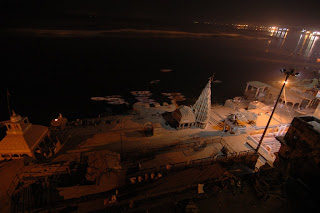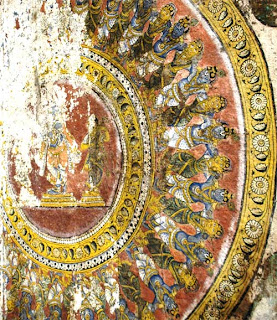 I am just the thought, I am just the memory; I am just the energy that has departed from my body as the mortal world brings what’s left of me down to cremation. I am history, I do not exist, and all those moments I spent trying tirelessly to get a better standard of living looks futile, now that I have left it behind. As the mortal world wakes up to this mournful truth, what worth was my life to me?
I am just the thought, I am just the memory; I am just the energy that has departed from my body as the mortal world brings what’s left of me down to cremation. I am history, I do not exist, and all those moments I spent trying tirelessly to get a better standard of living looks futile, now that I have left it behind. As the mortal world wakes up to this mournful truth, what worth was my life to me? In this world I have just come to, I descend the steps of transition beyond death, where Yama awaits, to lead the way ahead. I have left the world I knew, I no longer know where to go or what to do. I am pure energy as I watch; the final rights take place for my soul. This body I left now lies there lifeless, clothed in flowers and washed in the Ganges. What was the worth of my life to me?
They place me on the funeral pyre, the sky blends into twilight as the hymns rise to calm the aura around me. I can hear the jingling anklets of the Ganges as she sweeps by me, I can hear the hymns as they rise around me and I can feel Mata Annapurni as she picks me and lays me like a baby, in this new world, on her lap to set me free. The fire rises, the smoke climbs, I have begun my journey. I hear the sweet notes of the Mrityunjaya as Lord Shiva finally comes to me. I lay here, bathed in the last moments of worldly attention, the last gift of mankind to me, as I wonder what the worth of my life was to me.
I am the soul that watches on, I am the fire that eats into my being; I am the ash that is left of me. I feel the warm feet of Kali as they press me down calming me, one foot she places on my leg, the other she covers over my heart. In the raging fires, her sweet smile cools my soul. I offer my head, my balidaan to the mother, as my head she lovingly takes in her hand. Out there in the mortal world the crowd watches on as a bamboo is smashed over my head. The skull cracking noise, they set me free, I have left this world, but what worth was my mortal life to me?
This surging energy, this warmth of the Mother, as the guiding force of Yama, leads me on to the sweet smile of the Lord. I am one, I am none, I am and I am not. I am the smile you put up on your wall, I am that energy gone, I was and now I am not, yet what good was that life to me?
This state is not a world, not life, not anything you and I can define, this state is what the mind would reckon, this state is what they tried to reveal. This state is what you really are; this state is what you were always meant to be. This state is Shiva, this state is shakti, this state is energy, this state is beyond the limits of my mortal remains. This state is what I will be within the womb of my mortal mother when I re-enter this world called life. Yet, what was the worth of my previous life to me?
Shakti is the mortal carrier, Shiva the potent seed, dormant to be awoken when I re-enter. The union was sacred, the union was essential to lay the path for me. I am shakti, I am life, I am energy that awakens within this womb, life that we relate to, life that we witness, life for which we try to reach some form of immortality. And yet I wonder why I need another life, another tiring journey when I still don’t know the worth of the previous life to me.
I am soma, I am skanda, I am the pulse of immortality. I am the resultant energy of the universe, one that is born out of the union of Mahadeva Shiva and Parvati. I am amrita; I am the portion of immortality that wakes up again into a new life within the womb of my new mother. Karma has brought me back, karma pushes me to rebirth. I am born again, into another life, to elevate myself, to bring this down to equilibrium, to nothingness, to release myself for good, and rise and go to Kailasa, to go to Vaikunta, to the supreme energy that calls me home.




















